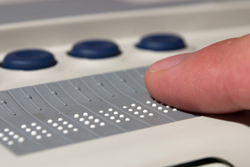Braille attachment for cell phones and tablets
Touch screens have changed the lives of billions of people with tablets, cell phones and MP4 players. However, the people who rely most on their sense of touch — the blind — have largely been left behind. Imagine an attachment that allows one to read full pages of text from the Internet in Braille. Thanks to work by EU-funded scientists on the project 'Nano-optical mechanical systems' (NOMS), such devices are in the development pipeline. Current technology for the visually impaired is limited in portability, cost, reliability and resolution. For example, to feel an image, one must create a printout using special paper. Optical actuation offers the potential to solve most of the major problems of current devices for this population group. Recently developed carbon nanotube photoactive polymers (CNT-PAPs) were thus a perfect building block for the NOMS microsystems. NOMS integrated CNT polymers into haptic devices employing microsystem technologies, a combination never before attempted. Research focused on both CNT-PAPs and liquid crystal elastomers (LCEs) with CNTs (LCE-CNTs). LCEs are another class of novel polymers somewhere in between liquids and solids in terms of their properties. The project members concentrated efforts on the characterisation and understanding of the behaviour of CNTs in the PAPs, followed by work on the LCE-CNTs. Using LCE-CNT materials that produced actuating parameters in the required range, scientists first assembled a single Braille tactile 'blister'. Subsequently, all materials, microsystems and software for a 10x10 tablet were developed and integrated. Finally, a blister array based on LCE-CNT doped with dye and demonstrating improved photo-actuating parameters was incorporated into the prototype 10x10 tablet. The tablet has been given to a partner for use in neuropsychology tests. Test results have elucidated the role of development in the visual system and related cortical circuits in audio–tactile space integration. Its commercialisation promises to radically change the lives of millions of visually impaired persons just as the Internet did for the visually 'healthy'.







